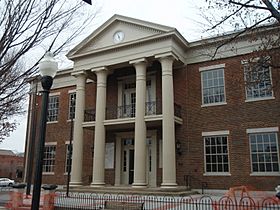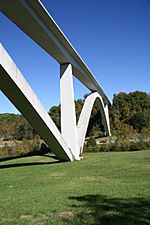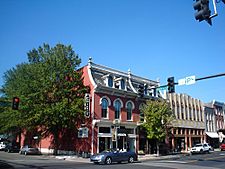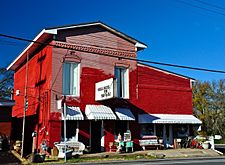Williamson County, Tennessee facts for kids
Quick facts for kids
Williamson County
|
||
|---|---|---|
| County of Williamson | ||
|
Williamson County Courthouse in Franklin, Old Town Archeological Site on the western side of the Big Harpeth River
|
||
|
||

Location within the U.S. state of Tennessee
|
||
 Tennessee's location within the U.S. |
||
| Country | ||
| State | ||
| Founded | October 26, 1799 | |
| Named for | Hugh Williamson | |
| Seat | Franklin | |
| Largest city | Franklin | |
| Area | ||
| • Total | 584 sq mi (1,510 km2) | |
| • Land | 583 sq mi (1,510 km2) | |
| • Water | 1.2 sq mi (3 km2) 0.2%% | |
| Population
(2020)
|
||
| • Total | 247,726 |
|
| • Density | 424.92/sq mi (164.06/km2) | |
| Time zone | UTC−6 (Central) | |
| • Summer (DST) | UTC−5 (CDT) | |
| Congressional district | 7th | |
Williamson County is a county in the U.S. state of Tennessee. As of the 2020 United States census, the population was 247,726. The county seat is Franklin, and the county is located in Middle Tennessee.
The county is named after Hugh Williamson, a North Carolina politician who signed the U.S. Constitution. Adjusted for relative cost of living, Williamson County is one of the wealthiest counties in the United States. Williamson County is part of the Nashville-Davidson–Murfreesboro–Franklin, TN Metropolitan Statistical Area. In the 19th century, tobacco and hemp were cultivated here, and planters also raised blooded livestock, including horses and cattle.
Contents
History
Pre-Civil War
The Tennessee General Assembly created Williamson County on October 26, 1799, from a portion of Davidson County. The county had originally been inhabited by at least five Native American cultures, including tribes of Cherokee, Chickasaw, Choctaw, Creek, and Shawnee. It is home to two Mississippian-period mound complexes, the Fewkes site and the Old Town site, built by a culture that preceded such tribes.
European-American settlers migrated into the area by 1798, preceded by traders. Most were from Virginia and North Carolina, part of a western movement after the Revolutionary War. In 1800, Abram Maury laid out Franklin, the county seat, which was carved out of part of a land grant he had purchased from Major Anthony Sharp. "The county was named in honor of Dr. Hugh Williamson of North Carolina, a colonel in the North Carolina militia and served three terms in the Continental Congress."
Many of the early inhabitants of the county were veterans who had been paid in land grants after the Revolutionary War. Those veterans who chose not to settle in the area often sold large sections of their land grants to speculators, who in turn subdivided the land and sold off smaller lots. Prior to the Civil War, the county was the second-wealthiest in the state, and part of the Middle Tennessee region. This area's resources of timber and rich soil (farmed for a diversity of crops including rye, corn, oats, tobacco, hemp, potatoes, wheat, peas, barley, and hay) provided a stable economy, as opposed to reliance on one cash crop.
Civil War
Williamson County was severely affected by the war. Three battles were fought within the county: the Battle of Brentwood, the Battle of Thompson's Station, and the Battle of Franklin, which had some of the highest fatalities of the war. The large plantations that were part of the economic foundation of the county were ravaged, and many of the county's youth were killed during the war. Many Confederate casualties of the Battle of Franklin were buried in the McGavock Confederate Cemetery near the Carnton plantation house. This cemetery, containing the bodies of 1,481 soldiers, is the largest private Confederate cemetery in America.
Post-Civil War
The agricultural and rural nature of the county continued as the basis of its economy into the early 1900s. "Most residents were farmers who raised corn, wheat, cotton and livestock." One of the first major manufacturers to establish operations in the county was the Dortch Stove works, which opened a factory in Franklin. The factory later developed as the Magic Chef factory, producing electric and gas ranges. After falling into disuse, this factory complex was restored in the late 1990s. It is used for office space and considered a "model historic preservation adaptive reuse project."
Since the completion of the Interstate Highway System and the rapid expansion of Nashville, Tennessee since the mid-20th century, Williamson County has undergone tremendous growth, requiring investment in infrastructure and schools, and rapidly changing its character. Between 1990 and 2000, the county's population increased 56.3 percent, mostly in the northern part of the county, including Franklin. As of Census estimates in 2012, Franklin has more than 66,000 residents (a fivefold increase since 1980) and ranks as the eighth-largest city in the state. The southern part of the county remains primarily rural pastoral usage. Spring Hill is a growing city in this area.
Geography
According to the U.S. Census Bureau, the county has a total area of 584 square miles (1,510 km2), of which 583 square miles (1,510 km2) is land and 1.2 square miles (3.1 km2) (0.2%) is water. The Harpeth River and its tributary, the Little Harpeth River, are the county's primary streams.
Adjacent counties
- Davidson County (north)
- Rutherford County (east)
- Marshall County (southeast)
- Maury County (south)
- Hickman County (southwest)
- Dickson County (northwest)
- Cheatham County (north)
National protected area
- Natchez Trace Parkway
State protected areas
- Carter House State Historic Site
- Haley-Jaqueth Wildlife Management Area
Demographics
The county population decreased from a high in 1880 over most of the next several decades, due in large part to African Americans moving to towns and cities for work, or out of the area altogether. The oppression of Jim Crow and related violence and the decline in the need for farm labor in the early 20th century, as mechanization was adopted, resulted in many blacks leaving Tennessee for industrial cities of the North and Midwest in the Great Migration.
The total 1880 county population was not surpassed until 1970. Combined with the rapid increase in white newcomers in new suburban developments in the county since the late 20th century, African Americans now constitute a small minority.
| Historical population | |||
|---|---|---|---|
| Census | Pop. | %± | |
| 1800 | 2,868 | — | |
| 1810 | 13,153 | 358.6% | |
| 1820 | 20,640 | 56.9% | |
| 1830 | 26,638 | 29.1% | |
| 1840 | 27,006 | 1.4% | |
| 1850 | 27,201 | 0.7% | |
| 1860 | 23,827 | −12.4% | |
| 1870 | 25,328 | 6.3% | |
| 1880 | 28,313 | 11.8% | |
| 1890 | 26,321 | −7.0% | |
| 1900 | 26,429 | 0.4% | |
| 1910 | 24,213 | −8.4% | |
| 1920 | 23,409 | −3.3% | |
| 1930 | 22,845 | −2.4% | |
| 1940 | 25,220 | 10.4% | |
| 1950 | 24,307 | −3.6% | |
| 1960 | 25,267 | 3.9% | |
| 1970 | 34,330 | 35.9% | |
| 1980 | 58,108 | 69.3% | |
| 1990 | 81,021 | 39.4% | |
| 2000 | 126,638 | 56.3% | |
| 2010 | 183,182 | 44.7% | |
| 2020 | 247,726 | 35.2% | |
| U.S. Decennial Census 1790-1960 1900-1990 1990-2000 2010-2020 |
|||
2020 census
| Race | Number | Percentage |
|---|---|---|
| White (non-Hispanic) | 200,408 | 80.9% |
| Black or African American (non-Hispanic) | 9,709 | 3.92% |
| Native American | 393 | 0.16% |
| Asian | 12,879 | 5.2% |
| Pacific Islander | 115 | 0.05% |
| Other/Mixed | 9,961 | 4.02% |
| Hispanic or Latino | 14,261 | 5.76% |
As of the 2020 United States census, there were 247,726 people, 84,393 households, and 68,001 families residing in the county. The population increase of 64,544, or 35.2% over the 2010 figure of 183,182 residents, represents the largest net increase in the county's history.
2010 census
As of the census of 2010, there were 183,182 people, 64,886 households, and 51,242 households residing in the county. The population density was 314.21 persons per square mile. The housing unit density was 111.30 units per square mile. The racial makeup of the county was 90.05% White, 4.34% African American, 3.01% Asian, 0.22% Native American, 0.04% Pacific Islander, and 1.32% from two or more races. Those of Hispanic or Latino origins constituted 4.46% of the population. Williamson County is estimated to be the county in Tennessee with the highest percentage of Asian residents.
Of all of the households, 41.11% had children under the age of 18 living in them, 68.08% were married couples living together, 2.67% had a male householder with no wife present, 8.22% had a female householder with no husband present, and 21.03% were non-families. 17.73% of all households were made up of individuals, and 5.85% had someone living alone who was 65 years of age or older. The average household size was 2.81 and the average family size was 3.20.
The age distribution was 29.28% under the age of 18, 61.00% ages 18 to 64, and 9.72% age 65 and older. The median age was 38.5 years. 51.23% of the population were females and 48.77% were males.
Economic data
Williamson County is ranked as the wealthiest county in Tennessee, as well as among the wealthiest counties in the country. In 2006 it was the 17th-wealthiest county in the country according to the U.S. Census Bureau, but the Council for Community and Economic Research ranked Williamson County as America's wealthiest county (1st) when the local cost of living was factored into the equation with median household income. In 2010, Williamson County is listed 17th on the Forbes list of the 25 wealthiest counties in America.
By 2006 Williamson County had a population of 160,781 representing 27.0% population growth since 2000. The census bureau lists Williamson as one of the 100 fastest-growing counties in the United States for the period 2000–2005.
Communities
Cities
- Brentwood
- Fairview
- Franklin (county seat)
- Spring Hill (partly in Maury County)
Towns
- Nolensville
- Thompson's Station
Unincorporated communities
- Allisona (partial)
- Arrington
- Berry's Chapel
- Bethesda
- Bethlehem
- Boston
- Brush Creek
- Burwood
- College Grove
- Clovercroft
- Cool Springs
- Fernvale
- Grassland
- Kirkland
- Leiper's Fork
- Liberty Hill
- Peytonsville
- Primm Springs
- Rudderville
- Southall
- Triune
Education
K-12 public education in the county is under the jurisdiction of Williamson County Schools, which operates 47 schools.
Higher education
- Belmont University, Williamson County Campus
- Columbia State Community College, Franklin Campus
- King University, Nashville Campus
- O'More College of Design
- University of Phoenix, Franklin Learning Center
- Williamson College
See also
 In Spanish: Condado de Williamson (Tennessee) para niños
In Spanish: Condado de Williamson (Tennessee) para niños








